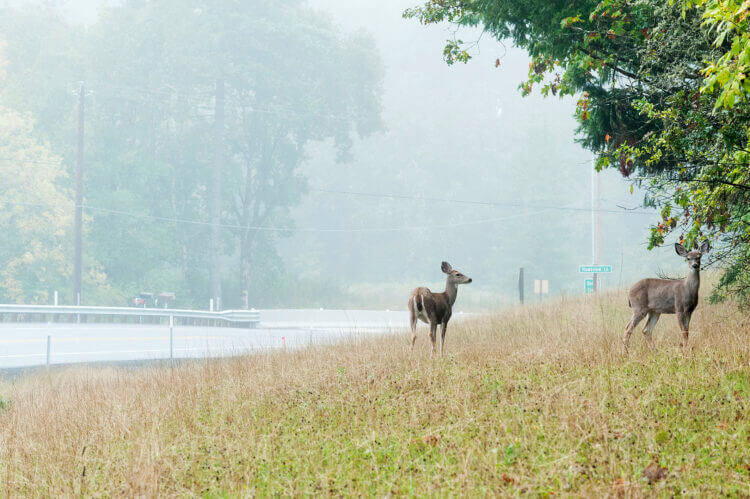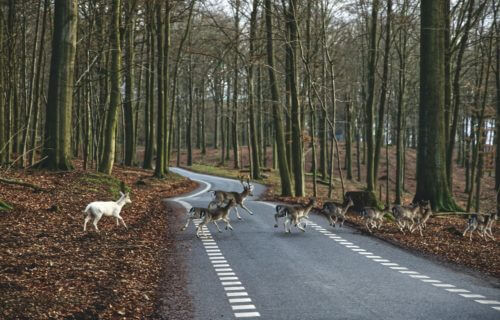SEATTLE — With Americans setting their clocks back in November as daylight saving time ends, a new report finds the annual clock-changing practice will likely cost thousands of deer their lives and injure thousands of drivers. Researchers from the University of Washington say ending the practice once and for all — and making DST permanent — would significantly cut down on the number of deer-vehicle collisions nationwide.
Researchers Calum Cunningham and Laura Prugh found that permanently adopting daylight saving time — meaning Americans would never change their clocks again after springing forward in March — would save over 36,000 deer each year. Their estimates show that permanent DST would also prevent 33 human deaths and over 2,000 injuries. This would lead to a savings of roughly $1.19 billion resulting from damage and injuries.
Making DST permanent would mean the skies over the U.S. stay brighter later into the evening. Currently, there are approximately 2.1 million deer-vehicle collisions across the U.S. each year. These accidents kill 440 people, cause roughly 59,000 injuries, and cost drivers more than $10 billion annually.
“Wildlife-vehicle collisions are a huge and growing problem,” Cunningham says in a university release. “There are social costs — people killed and injured — and it’s also a conservation problem as it’s one of the largest sources of human-caused mortality of wildlife.”
Although the U.S. Senate passed The Sunshine Protection Act in March 2022, which would make DST permanent, the U.S. House of Representatives has not picked up the discussion in order to pass it into law.
Why does DST lead to so many deer crashes?
The study analyzed wildlife-vehicle collision data from 23 states, finding that the vast majority involve two species, white-tailed deer in the east and mule deer in the west. Study authors looked at more than one million deer-vehicle collisions from 1994 to 2021 and discovered that the risk of a collision generally depends on how much human and deer activity overlaps.
Specifically, the most active times are around dawn and dusk. Crashes are mostly likely to occur in the hours between sunset and sunrise the next morning. According to the research, crashes were 14 times more common two hours after sunset and two hours before sunrise.

Concerningly, deer-vehicle collisions peak in the fall. In fact, nearly 10 percent occur during the two-week period around the switch from DST to standard time — when Americans “fall back” and it gets darker earlier.
Study authors note that falling back leads to a significant increase in the number of people driving after sunset. This led to a 16-percent spike in the number of deer collisions the week after the time shift. Researchers add that the fall is also mating season for deer, increasing their activity by as much as 50 percent.
“We believe that this fall spike really happens due to the overlap of these two factors: the breeding season and the change from daylight saving time back to standard time,” Prugh says. “We don’t see a corresponding shift in deer-vehicle collisions in the spring during the other time change, and we believe that’s in part because spring is not a breeding season for deer.”
How can brighter nights change all this?
On the opposite side of the spectrum, the team’s model reveals that making standard time permanent would lead to even more deer deaths and human injuries over the course of a single year. They estimate that turning the clocks back permanently would increase deer-vehicle collisions by 73,660 and lead to 66 more human fatalities annually. There would also be more than 4,000 more driving injuries, according to the study.
Meanwhile, the estimates show that making DST permanent would decrease deer crashes by 2.3 percent.
Study authors note that doing away with the time shift in any scenario would eliminate the “social jetlag” resulting from our circadian rhythms getting out of sync. Previous studies have found that changing the clocks each year causes a number of problems related to sleep patterns and our internal biological clock.
“Humans today have this ‘evening bias’ in our activity: we get up later and stay active later than what the sun is telling us to do,” Cunningham says. “As long as people are living their lives ‘by the clock,’ which animals do not, people need to be aware of risks and make adjustments where we can. If people are thinking about what they can do for wildlife and for their own lives, reducing driving during dark hours is likely to help significantly. In areas with deer, the risk of harming wildlife and yourself while driving is 14 times higher when it is dark.”
The findings are published in the journal Current Biology.


Let’s just ban driving, think of all the deer we could “save”.
Make it PLUS TWO … and keep it there!!!